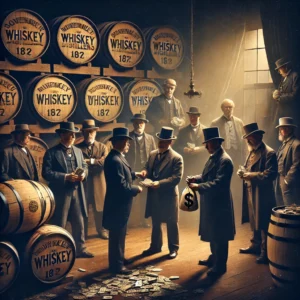The Whiskey Ring scandal of the 1870s stands as one of the most notorious examples of government corruption in American history. Involving a network of government officials and whiskey distillers, the scandal aimed to defraud the federal government of millions of dollars in tax revenues. This scandal not only highlighted the deep-seated corruption within Ulysses S. Grant’s administration but also underscored the challenges of governance during the Reconstruction era.
The Fraudulent Scheme
The scheme was both intricate and extensive. Whiskey distillers, in collusion with government officials, avoided paying excise taxes by underreporting the amount of whiskey they produced. Revenue agents were bribed to turn a blind eye to these discrepancies, creating a lucrative operation that diverted millions of dollars in tax revenue away from the federal government. This illicit money was then funneled into political campaigns and personal enrichment, perpetuating a cycle of corruption and greed.
Key Players and Their Roles
The key figures in the Whiskey Ring included high-ranking government officials, Treasury agents, and prominent whiskey distillers. The central figure in the government’s investigation was Secretary of the Treasury Benjamin H. Bristow, who was determined to dismantle the corrupt network. Orville E. Babcock, President Grant’s personal secretary, was one of the most notable officials implicated in the scandal. Despite being acquitted, his involvement cast a long shadow over Grant’s presidency.
Investigation and Public Outcry
The investigation into the Whiskey Ring began in earnest in 1875, spearheaded by Secretary Bristow. The uncovering of the scandal led to a public outcry, with citizens demanding accountability and justice. The exposure of such widespread corruption within the government eroded public trust and fueled a broader discourse on the need for reform.
Grant’s Response and Babcock’s Trial
President Grant, known for his loyalty to friends, faced a difficult position. Despite his efforts to support Bristow’s investigation, his association with Babcock and other implicated officials marred his administration’s reputation. Babcock’s trial was a focal point of the scandal. Although he was acquitted due to insufficient evidence, the trial underscored the depth of the corruption and the challenges of prosecuting high-ranking officials.
Outcome and Impact
The aftermath of the Whiskey Ring scandal saw several officials convicted and sentenced to prison. The scandal severely tarnished Grant’s presidency, despite his insistence that he was unaware of the illegal activities. The impact of the scandal was profound, leading to significant changes in how the government handled tax collection and reinforcing the need for transparency and accountability in public office.
Long-Term Effects
The Whiskey Ring scandal remains a significant example of post-Civil War corruption. It highlighted the vulnerabilities within the government and the importance of rigorous oversight. The scandal also contributed to the growing movement for civil service reform, eventually leading to the Pendleton Civil Service Reform Act of 1883, which aimed to curb patronage and corruption in federal employment.

The Whiskey Ring scandal serves as a historical lesson on the importance of vigilance and accountability in government operations. While President Grant’s efforts to combat corruption were genuine, his administration’s reputation suffered greatly due to the actions of a few unscrupulous individuals. The legacy of the Whiskey Ring scandal endures as a cautionary tale about the perils of unchecked power and the essential role of integrity in public service.
